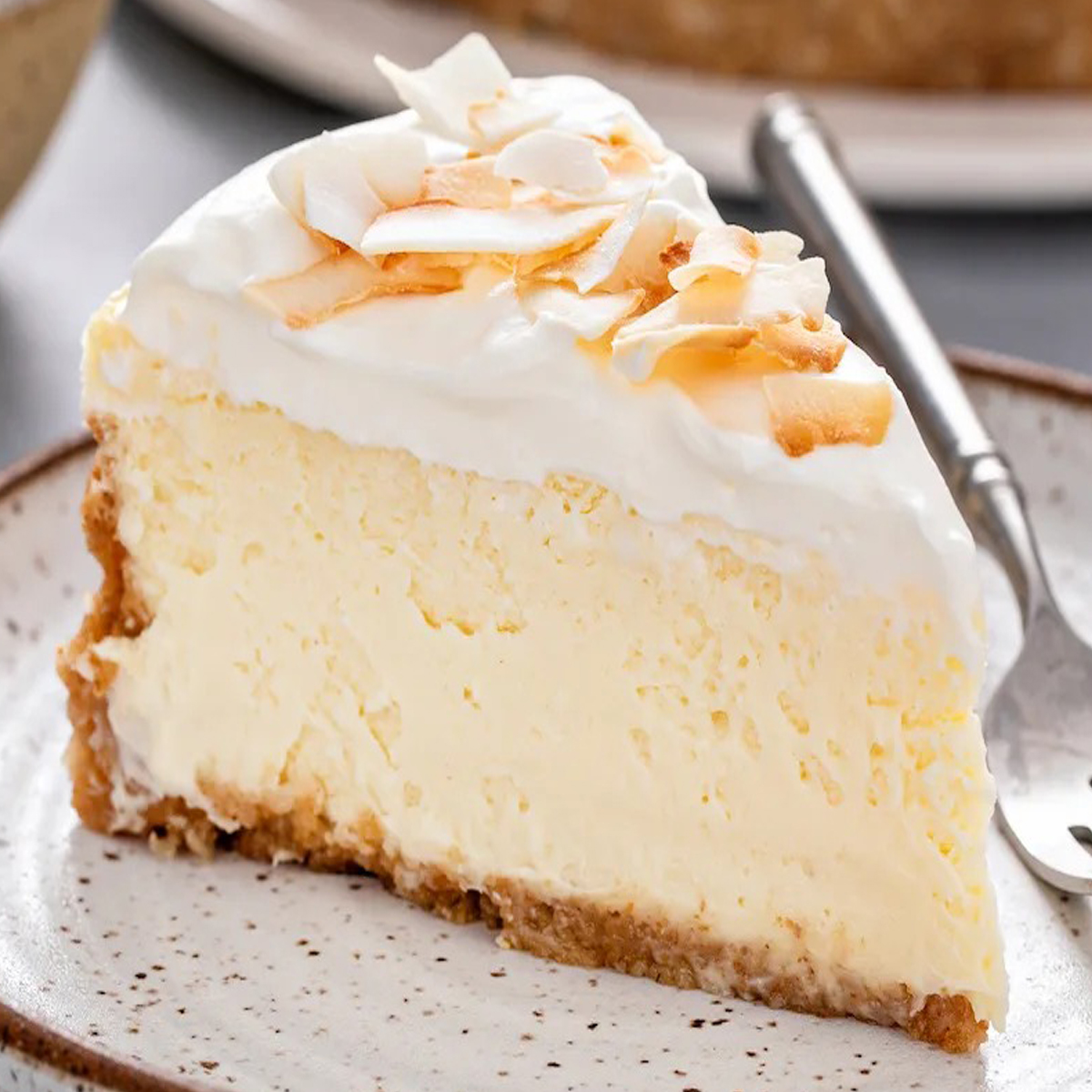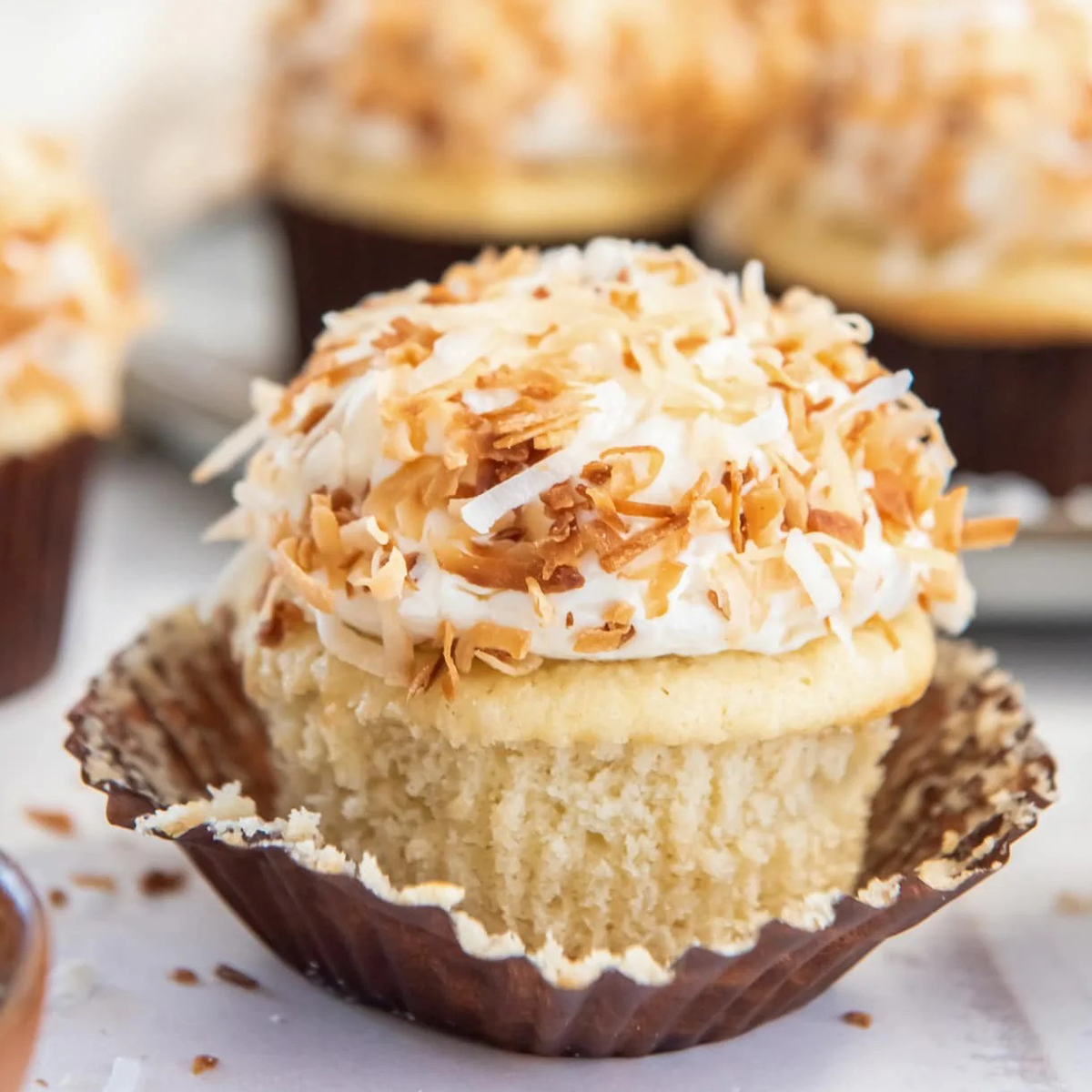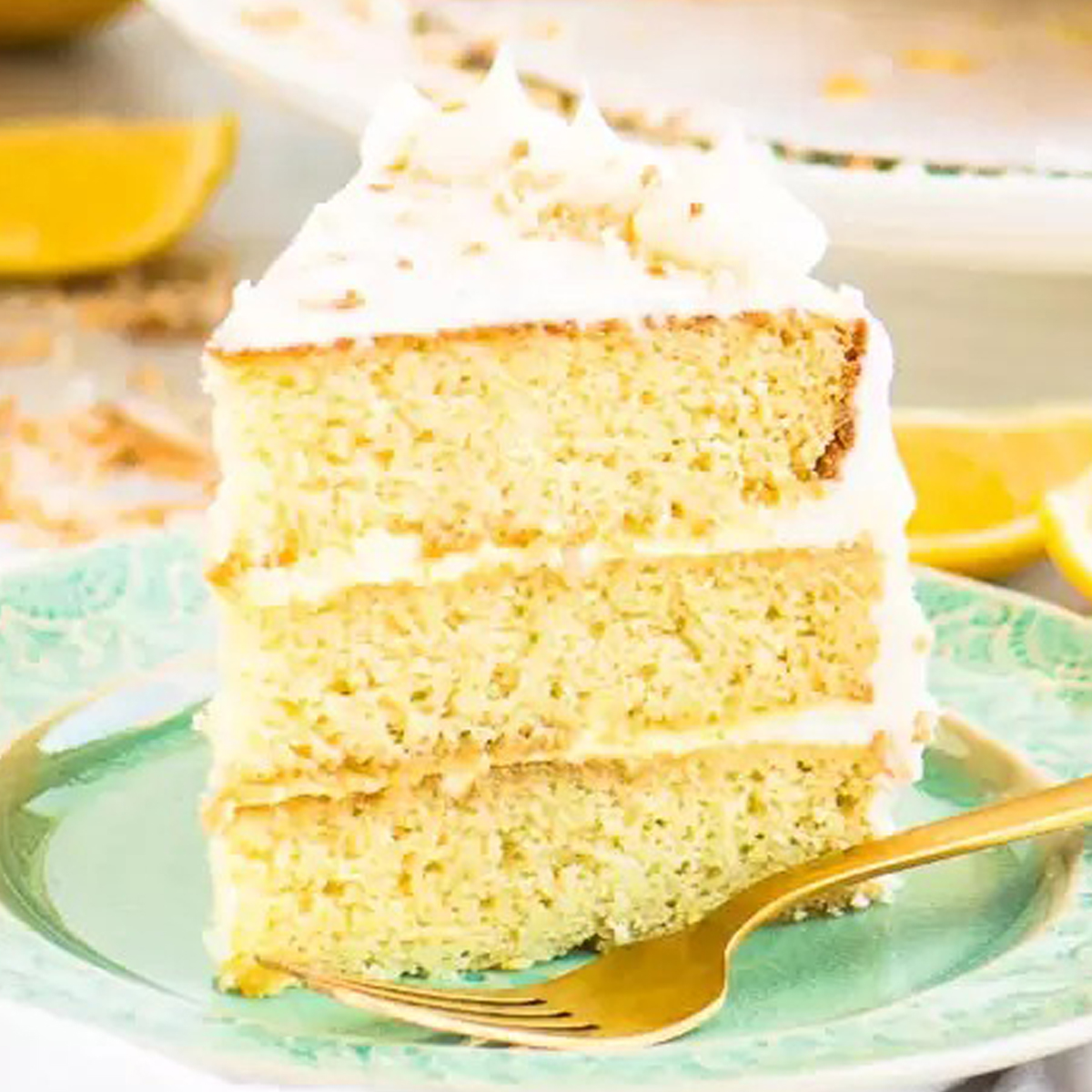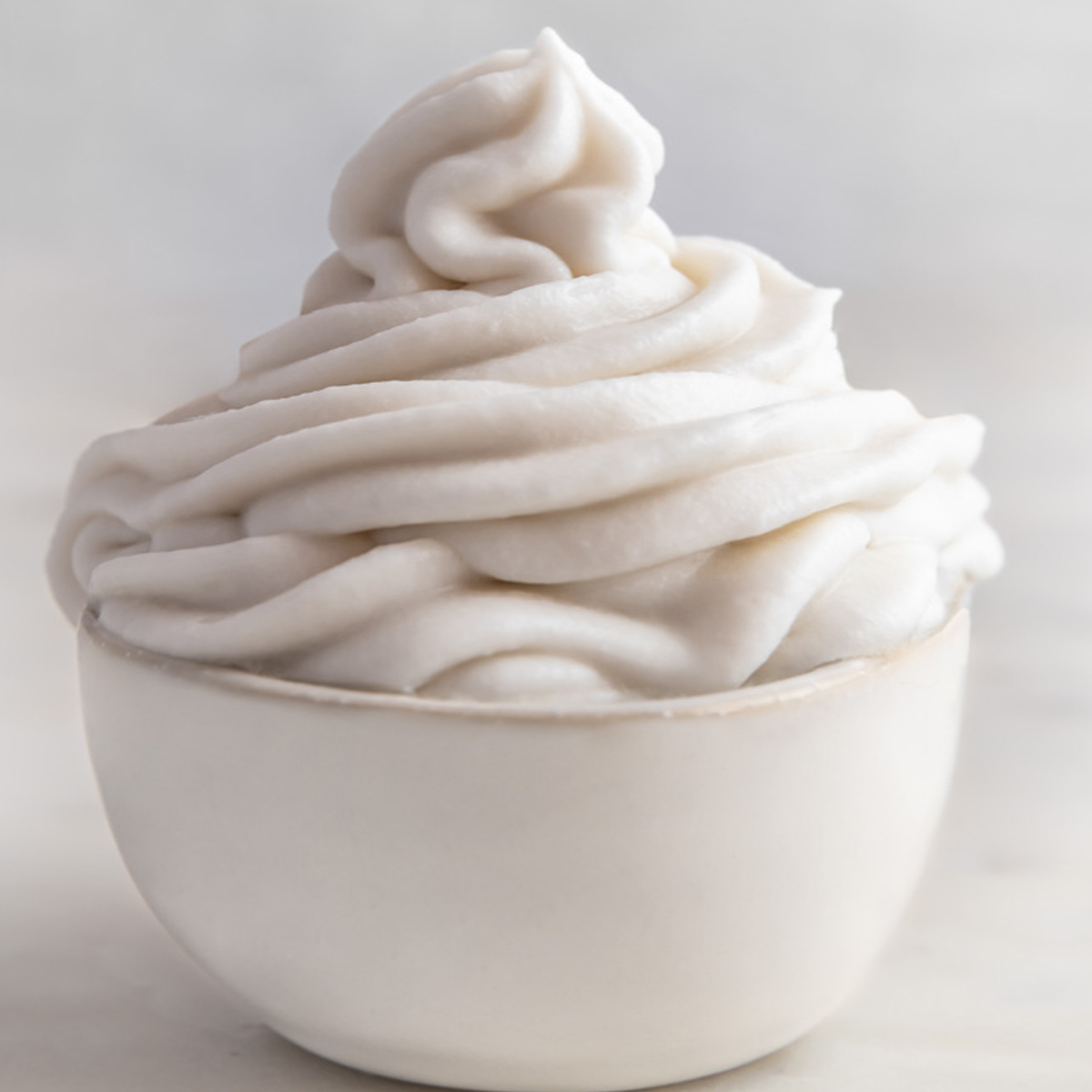Coconut cake, a delightful confection beloved by many, embodies the tropical essence of coconut in every bite. This elegant dessert showcases layers of tender cake infused with the rich flavor of coconut, often complemented by creamy frosting and delicate coconut flakes. The subtle sweetness of coconut harmonizes with the moist cake layers, creating a symphony of textures and tastes that transport you to sun-kissed beaches and palm-fringed shores. Whether adorned with billowy white frosting, toasted coconut shavings, or adorned with edible blossoms, a slice of coconut cake is an invitation to savor the tropics and indulge in a moment of pure dessert bliss.
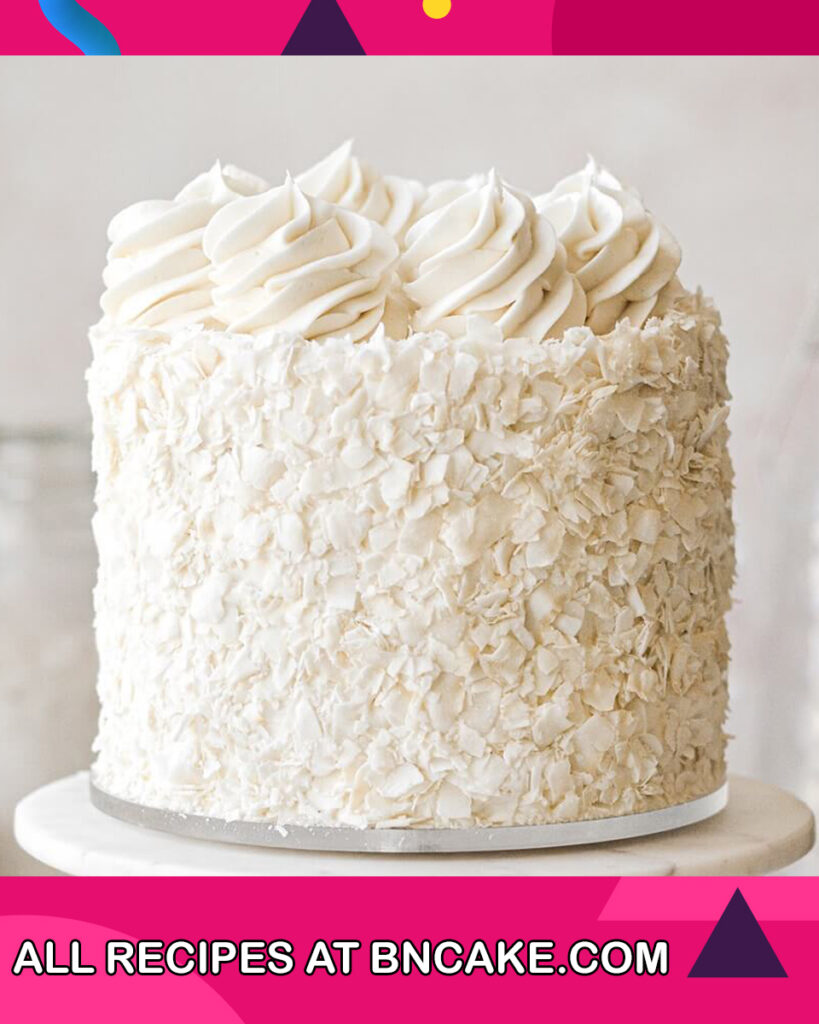
What Is Coconut Cake?
Coconut cake is a delectable dessert that features the distinct flavor and texture of coconut as its central element. This cake typically consists of layers of tender, moist cake that are infused with coconut flavor through the use of ingredients such as coconut milk, coconut extract, or shredded coconut. The cake layers are often sandwiched together and covered with coconut-flavored frosting, which can be buttercream, cream cheese, or whipped cream-based.
One of the defining characteristics of coconut cake is its appearance, often adorned with shredded or toasted coconut on the frosting, giving it a delightful visual appeal that hints at the tropical flavors within. Some variations of coconut cake also incorporate fillings like coconut custard or fruit preserves to add more complexity to the taste and texture.
Coconut cake can be enjoyed as a dessert for various occasions, from birthdays and weddings to everyday celebrations. Its inviting flavor profile, combined with the unique texture of coconut, makes it a favorite among those who appreciate the taste of the tropics in a delightful cake form.
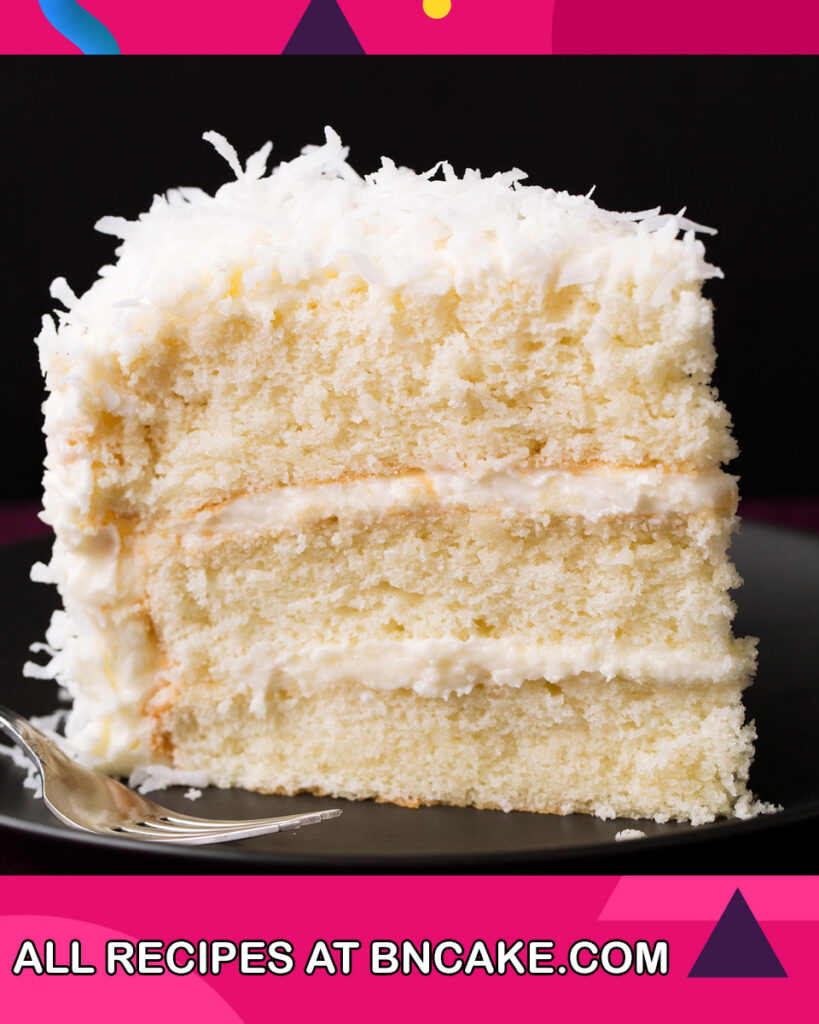
Why You Will Love Coconut Cake Recipe?
- Tropical Escape: The rich, authentic coconut flavor of this cake transports you to a tropical paradise with every bite, invoking feelings of relaxation and exoticism.
- Texture Harmony: The combination of tender cake layers and the subtle crunch of shredded coconut creates a harmonious contrast that’s a delight to the palate.
- Decadent Indulgence: A coconut cake offers a perfect balance of sweetness and coconut essence, making it a luxurious treat that’s not overly sugary.
- Customization: You can customize the recipe to match your preference, adjusting the level of coconut flavor, frosting sweetness, and even incorporating creative fillings.
- Visually Stunning: The layers of moist cake, creamy frosting, and toasted coconut shavings create a visually stunning dessert that’s perfect for celebrations.
- Versatile Occasions: From birthdays to weddings, or even as a sweet indulgence on a regular day, coconut cake is versatile and fitting for various occasions.
- Celebrating Diversity: Coconut cake celebrates the unique taste of coconut, catering to those who love its distinct, nutty flavor.
- Joy of Baking: Crafting a coconut cake from scratch is a rewarding experience that lets you take pride in your creation and share your baking talents with others.
- Impressive Presentation: Serving a homemade coconut cake showcases your baking skills and attention to detail, making it an impressive centerpiece for any dessert table.
- Nostalgia and Comfort: For those with fond memories of tropical vacations or childhood treats, coconut cake can evoke a sense of nostalgia and comfort.
- Recipe Experimentation: You can experiment with variations, such as coconut cream fillings, different frosting flavors, or incorporating fresh fruit for unique twists.
- Sharing Joy: Sharing slices of your homemade coconut cake with family and friends creates moments of joy and togetherness over a delicious dessert.
In essence, a homemade coconut cake recipe offers a delightful escape to a tropical haven, with its flavorful layers and irresistible charm. Whether you’re an experienced baker or new to the kitchen, the journey of crafting this dessert promises immense satisfaction and countless moments of enjoyment.

Ingredients For Coconut Cake
Ingredients for the Cake:
- 1 cup unsalted butter, softened
- 2 cups granulated sugar
- 4 large eggs
- 1 teaspoon vanilla extract
- 1 teaspoon coconut extract
- 3 cups all-purpose flour
- 1 tablespoon baking powder
- 1/2 teaspoon salt
- 1 cup coconut milk (canned or fresh)
- 1/2 cup sweetened shredded coconut
Ingredients for the Coconut Cream Cheese Frosting:
- 8 ounces cream cheese, softened
- 1/2 cup unsalted butter, softened
- 4 cups powdered sugar
- 1 teaspoon vanilla extract
- 1 teaspoon coconut extract
- 1/2 cup sweetened shredded coconut (for decoration)
How To Make Coconut Cake
- Prepare the Cake Batter:
- Cream the Unsalted Butter and Granulated Sugar until light and fluffy.
- Add the Large Eggs one by one, followed by Vanilla Extract and Coconut Extract.
- In a separate bowl, whisk the All-Purpose Flour, Baking Powder, and Salt together.
- Gradually add the dry ingredients to the wet mixture, alternating with Coconut Milk. Fold in the Sweetened Shredded Coconut.
- Bake the Cake:
- Divide the batter between two greased and floured 9-inch round cake pans.
- Bake at 350°F (175°C) for about 25-30 minutes, or until a toothpick inserted comes out clean.
- Cool the cakes in the pans before transferring to a wire rack.
- Prepare the Frosting:
- Beat the Cream Cheese and Unsalted Butter until smooth.
- Gradually add the Powdered Sugar and beat until creamy and well combined.
- Mix in Vanilla Extract and Coconut Extract.
- Assemble the Cake:
- Place one cake layer on a serving plate and spread a layer of frosting over it.
- Top with the second cake layer and frost the top and sides with the remaining frosting.
- Decorate:
- Optional: Press Sweetened Shredded Coconut onto the frosting for decoration.
- Serve and Enjoy:
- Slice and serve the delicious homemade coconut cake, savoring the delightful blend of flavors and textures.
This formula yields a magnificent coconut cake with layers of moist cake, coconut cream cheese frosting, and a touch of shredded coconut for an added tropical twist. Remember to adjust quantities based on your desired servings and preferences.
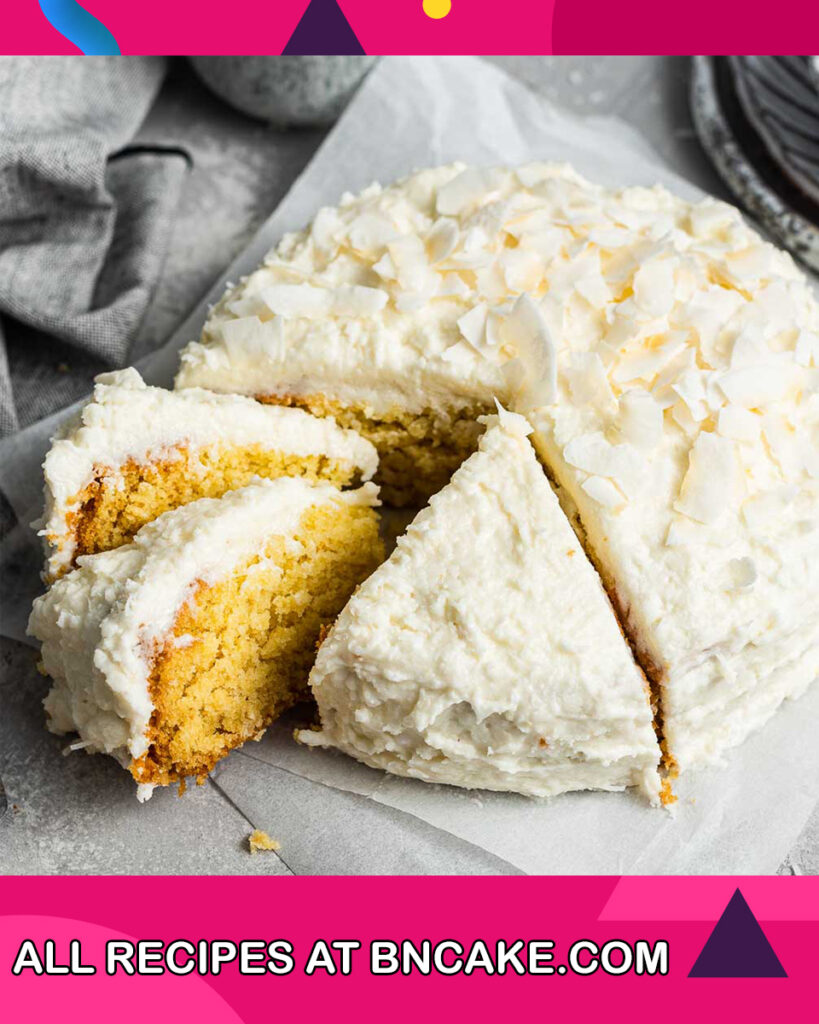
How To Serve Coconut Cake
Serving coconut cake is a delightful experience, as this tropical-inspired dessert offers a blend of flavors and textures that’s both comforting and indulgent. Here’s how to serve coconut cake to make the most of its deliciousness:
- Slice and Display: Place the whole coconut cake on a decorative cake stand or serving platter. This creates an inviting centerpiece for your dessert table.
- Individual Plates: Slice the coconut cake into individual servings using a sharp knife. Use a cake server or spatula to lift each slice onto dessert plates.
- Garnish: Before serving, you can garnish each slice with additional sweetened shredded coconut for an extra touch of coconut flavor and visual appeal.
- Whipped Cream: Serve coconut cake with a dollop of freshly whipped cream on the side. The light creaminess complements the richness of the cake.
- Fruit Compote: Accompany coconut cake with a spoonful of fruit compote, such as raspberry or mango. The tartness of the fruit adds a lovely contrast to the sweetness of the cake.
- Fresh Berries: Arrange a handful of fresh berries, like strawberries or blueberries, around each slice of cake. The vibrant colors and juicy sweetness enhance the overall presentation.
- Ice Cream: A scoop of coconut or vanilla ice cream pairs wonderfully with coconut cake, adding a cool and creamy element to the dessert.
- Drizzle Sauce: Drizzle a thin stream of chocolate or caramel sauce over the cake slice before serving for an extra layer of flavor.
- Edible Flowers: For a touch of elegance, consider adorning each slice with a delicate edible flower, like pansies or violets.
- Pair with Coffee or Tea: Serve coconut cake alongside a freshly brewed cup of coffee or tea to balance the sweetness with a hint of bitterness.
- Dessert Buffet: If you’re hosting a party or gathering, include coconut cake as part of a dessert buffet featuring a variety of sweet treats.
- Special Occasions: Celebrate birthdays, anniversaries, or other special occasions by serving coconut cake as the grand finale to your meal.
Remember, the goal is to create a harmonious experience for your guests by balancing flavors, textures, and presentation. Whether enjoyed as a standalone dessert or as part of a larger spread, coconut cake is sure to be a crowd-pleaser.

How To Store Coconut Cake
Proper storage is essential to maintain the freshness and quality of your coconut cake. Here’s how to store coconut cake to keep it delicious for as long as possible:
- Cool Completely: Before storing, make sure the coconut cake has cooled completely. Warm cake can create condensation inside the storage container, leading to moisture-related issues.
- Wrap in Plastic Wrap: If the cake is whole, tightly wrap it in several layers of plastic wrap. This helps prevent air and moisture from getting in and keeps the cake from drying out.
- Use an Airtight Container: Alternatively, you can place the wrapped cake in an airtight container. Make sure the container is large enough to accommodate the cake without pressing against the sides.
- Refrigerate: Coconut cake is best stored in the refrigerator to maintain its freshness. The cool temperature helps prevent spoilage and keeps the frosting from melting or becoming overly soft.
- Avoid Odors: Ensure that the storage container or wrapping is odor-free. Coconut cake can absorb odors from other foods in the fridge.
- Separate Layers: If you’ve assembled the cake with multiple layers of frosting, consider placing parchment paper or wax paper between the layers to prevent sticking and preserve the frosting’s appearance.
- Consume Promptly: While coconut cake can stay fresh in the refrigerator for several days (usually around 3-5 days), it’s best to consume it within the first few days for the best taste and texture.
- Freezing Option: If you want to store the cake for a longer period, you can freeze it. Wrap individual slices or the entire cake in plastic wrap followed by aluminum foil, and place it in an airtight freezer-safe container. Frozen coconut cake can last for several weeks to a few months.
- Thawing Frozen Cake: When ready to enjoy frozen cake, thaw it in the refrigerator for several hours or overnight. Allow it to come to room temperature before serving for the best texture and flavor.
- Avoid Moisture: When thawing frozen cake, be cautious about moisture. Don’t unwrap it until it has thawed, as condensation can form on the cake’s surface.
Remember, the goal is to protect your coconut cake from drying out or becoming stale. Proper storage ensures that you can enjoy the same delicious taste and texture, even after a few days or weeks.
RELATED RECIPES
Tips And Tricks For Coconut Cake
Baking the Cake:
- Room Temperature Ingredients: Ensure that your butter, eggs, and other dairy ingredients are at room temperature. This promotes even mixing and helps create a smoother batter.
- Gentle Mixing: When incorporating dry ingredients into wet, mix just until combined. Overmixing can lead to a dense cake.
- Measuring Flour: To avoid a heavy cake, measure your flour by spooning it into the measuring cup and leveling it off with a flat edge.
- Coconut Milk: If using canned coconut milk, make sure to shake the can well before measuring to evenly distribute the cream and liquid.
Flavor Enhancement:
- Quality Extracts: Invest in high-quality vanilla and coconut extracts for authentic and rich flavors.
- Toasted Coconut: For enhanced texture and flavor, lightly toast shredded coconut in the oven until golden brown before adding it to the batter or using it as decoration.
- Layered Fillings: Consider adding a layer of coconut custard or fruit preserves between the cake layers for added flavor and dimension.
Frosting and Decoration:
- Room Temperature Cream Cheese and Butter: For smooth and creamy frosting, ensure that your cream cheese and butter are fully softened.
- Gradual Sugar Addition: Add powdered sugar gradually to your frosting mixture. This prevents clumps and ensures a smooth texture.
- Frosting Consistency: If your frosting is too thin, add more powdered sugar. If it’s too thick, a splash of milk or cream can help achieve the desired consistency.
- Crumb Coat: Before applying the final layer of frosting, consider applying a thin “crumb coat” layer. This seals in any loose crumbs and ensures a clean finish.
- Chill Between Layers: After applying the crumb coat or each layer of frosting, refrigerate the cake briefly to set the frosting and make the process easier.
Presentation and Serving:
- Even Cake Layers: Trim the tops of your cake layers if they’re uneven to create a level surface for stacking.
- Even Frosting Application: Use an offset spatula to apply frosting evenly and achieve a smooth finish.
- Chill Before Serving: Allow your fully frosted cake to chill in the refrigerator for a little while before serving. This helps the frosting set and makes slicing cleaner.
- Room Temperature Slices: If the cake is chilled, allow slices to come to room temperature for a few minutes before serving. This enhances the flavors and textures.
Remember, making a coconut cake is both a culinary adventure and an art. Experiment with these tips and tricks to create a cake that’s not only visually stunning but also a delight to your taste buds.
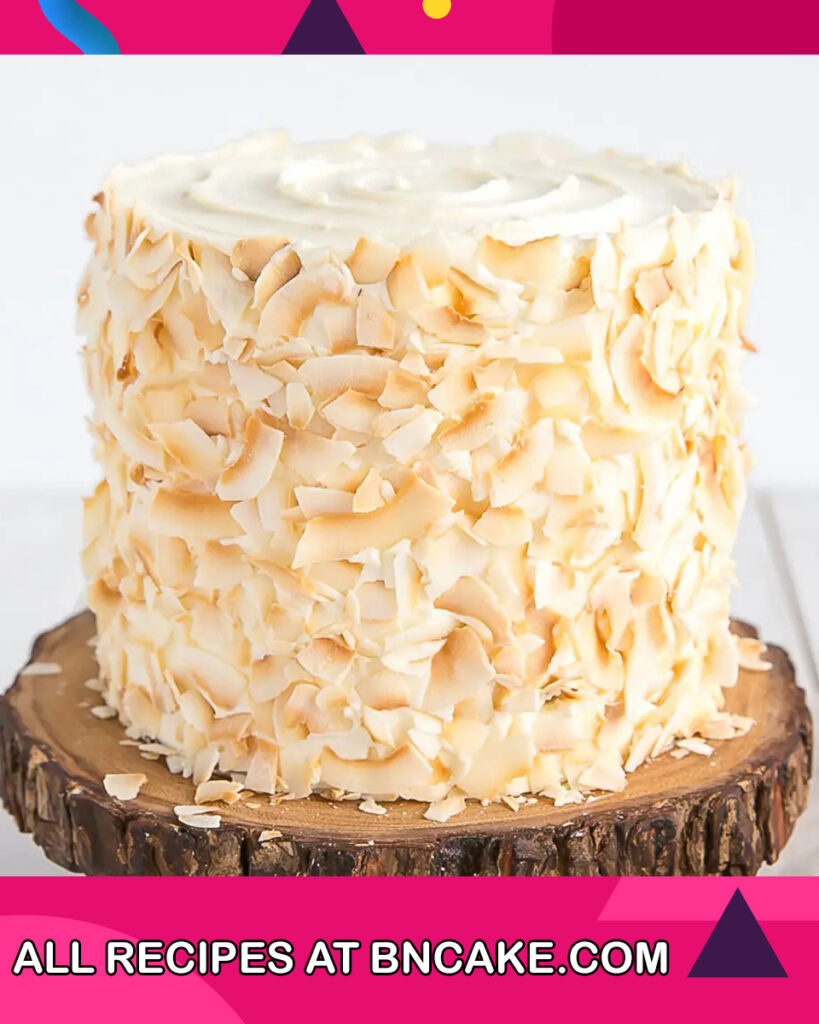
FAQs And Troubleshooting
FAQs:
- Can I use desiccated coconut instead of shredded coconut in the cake batter?
Yes, you can use desiccated coconut instead of shredded coconut, but keep in mind that desiccated coconut is drier and finer. Adjust the quantity accordingly and consider soaking it in warm coconut milk to soften it slightly before adding it to the batter. - Can I use coconut cream instead of coconut milk in the cake recipe?
Yes, you can use coconut cream in place of coconut milk, but it’s more concentrated. Dilute it with a bit of water to achieve a similar consistency to coconut milk. - Can I substitute coconut extract with coconut flavoring?
Coconut extract provides a stronger and more authentic coconut flavor. Coconut flavoring might work as a substitute, but the intensity of flavor might differ. Start with a smaller quantity of flavoring and adjust to taste. - Can I make this cake in advance?
Yes, you can make the cake layers in advance and freeze them, tightly wrapped. Thaw the layers before assembling and frosting the cake. Assemble and frost the cake a day before serving for the best texture and flavor. - Can I use a different type of frosting for this cake?
Absolutely! While the recipe includes a coconut cream cheese frosting, you can use other frostings like buttercream, whipped cream, or even a chocolate ganache.
Troubleshooting:
- Cake turned out dry:
Dryness can result from overbaking. Check for doneness a few minutes before the recommended time by inserting a toothpick into the center. If it comes out with a few moist crumbs, the cake is done. - Frosting is too runny:
If your frosting is too runny, it could be due to overly soft butter or cream cheese. Refrigerate the frosting for a short while to firm it up before using. - Frosting is too thick:
If your frosting is too thick, you can add a small amount of milk or coconut milk, a teaspoon at a time, while beating until you achieve the desired consistency. - Frosting doesn’t spread smoothly:
Ensure your cake layers are level and evenly cooled before frosting. If necessary, use a thin layer of frosting as a crumb coat before applying the final layer. - Cake layers stuck to the pan:
Grease and flour your cake pans well, or consider using parchment paper rounds at the bottom for easier release. - Cake sunk in the center:
Sinking can occur due to various factors, such as overmixing or opening the oven door too early. Make sure not to overmix the batter and avoid opening the oven door until the cake has set. - Cake has a strong baking powder taste:
Overuse of baking powder can lead to a bitter taste. Ensure you’re measuring accurately and not exceeding the recommended amount.
Remember, baking is a learning process, and even experienced bakers face challenges. Don’t be discouraged by issues—instead, use them as opportunities to refine your skills and perfect your coconut cake recipe.
Nutrition Information
The nutritional information for coconut cake can vary based on the specific recipe, portion sizes, and variations in ingredients used. However, I can provide you with a general approximation of the nutritional breakdown for a typical slice of coconut cake (assuming 12 servings per cake):
Calories: Around 350-400 calories per slice, Total Fat: Approximately 15-20 grams, Saturated Fat: Around 10-12 grams, Cholesterol: Approximately 50-70 milligrams, Sodium: Around 200-300 milligrams, Total Carbohydrates: Approximately 50-60 grams, Dietary Fiber: Around 1-2 grams, Sugars: Approximately 35-45 grams, Protein: Around 3-5 grams
Keep in mind that these values are based on an average slice size and typical ingredients. If your recipe uses different quantities or includes additional fillings, frostings, or decorations, the nutritional content will vary.
For a more precise nutritional analysis, it’s recommended to use a reliable recipe calculator or consult the nutritional information on the specific ingredients you’re using.


